Your Turnitin guidance is moving!
We’re migrating our content to a new guides site. We plan to fully launch this new site in July. We are making changes to our structure that will help with discoverability and content searching. You can preview the new site now. To help you get up to speed with the new guidance structure, please visit our orientation page .
Turnitin Draft Coach provides you with the ability to use Turnitin’s tools in your Google Docs to help you work towards the final draft of your assignment before you submit to your teacher.
Similarity Check
If instances are found where a user's writing is similar to or matches against a source in our database this will be flagged for your review in the Turnitin Draft Coach side panel.
The database includes billions of web pages: both current and archived content from the Internet, a database of student papers that have been submitted to Turnitin in the past, and a collection of documents, which consists of thousands of periodicals, journals, and publications.
Interpreting your results
The percentage of the similarity score is based on the amount of matching text in a document. It is perfectly natural for an assignment to match against some of our databases. If you've used quotes and referenced correctly, there will be instances where we will find a match and that is totally OK! The similarity score simply highlights any matching areas in your paper so your teacher can use this as an investigative tool to determine if the match is or is not acceptable. Each matching source is color-coded and listed numerically to make it easier to distinguish between multiple matches.

There are two parts to your Similarity Check:
-
Match - This is text that is very similar or the same as some text you have in your Google Doc. Your matches are highlighted in your Google Doc and the colors will correlate with the sources listed in your insight panel.
-
Source - The source is where a particular match has been found. This can be a webpage, a student paper, or a published journal. Your sources are listed numerically in your insight panel and it is possible to have multiple matches for each source. Selecting one of your sources will reveal information like how many matches were found for that particular source and where each match was found on that web page, student paper, or journal.
What can I do with the information included in my checks?
The information in your Turnitin Similarity Check should help you make decisions about how to improve your writing, whether that is in later drafts of the same assignment or on future assignments of a different nature. If you have the opportunity to revise your writing based on your Similarity Score, consider the following:
-
choose only the most significant quotes to include from your sources
-
summarize, paraphrase, or explain an idea in your own words rather than quoting it directly
-
cite all of your evidence using the appropriate citation style
What is a ‘good’ or ‘bad’ similarity score?
Turnitin does not set a similarity percentage that you should try to avoid or achieve. However, your school or teacher may have assigned a certain number as the acceptable threshold for assignments at your school. Consult your teacher for details on this threshold. Some similarity is usually expected and can simply mean that you have included source-based evidence which is a requirement for some assignments. If you have concerns or questions regarding any aspect of your similarity score, your teacher will be able to advise you.
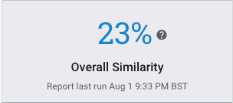
Don’t forget, you have a total of three reports that you can run for your draft. If your similarity score is higher than you would like, take a look at the highlighted matches and see where you can improve, and then run your report again when you are finished revising your first draft.
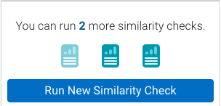
Citations Check
The Citations Check is used to help you identify when your citations are missing references or when your references are missing citations. This check focuses on identifying matching pairs of citations and references that you include in your text.
Interpreting your results
Your citations check will detect the number of citations, references, and the citation style that has been used in your draft. The number of citations should always be equal to or more than the number of references.

There are two Issues that a Citation Check will list if they are found:
-
Citation with no reference - Every citation should have a corresponding reference listed within your bibliography
-
Reference with no citation - Every reference in your bibliography should have at least one corresponding citation within your draft assignment
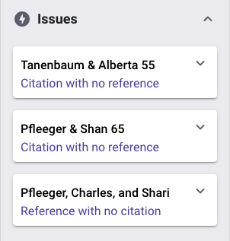
The citations check will not catch any sources that have neither a citation nor a reference. This would likely be shown in the Similarity Report as a match in our database.
All References will provide you with a list of the references within your bibliography. With each reference, it will display how many citations are linked to it. If the number of citations is 0, a purple, lightening Issue badge will appear on the reference to draw your attention to it. Citations with no corresponding reference will also be listed here, along with the page number of where it is located and an Issue badge.
What is the difference between a citation and a reference?
Citations and references are closely related but refer to two different pieces of information that should appear in your work.
-
A citation is a mention of a source within your text. Citations are usually included within parentheses brackets with note information like author, date of publication, or page number where the information can be found. The information within citations differs depending on which citation style you are using.
-
A reference is a description of each source that you use within your text. References are listed at the end of your document in alphabetical order and include information like author, source title, publisher, date of publication, etc. The information within references differs depending on which citation style you are using.
What can I do with the information included in my checks?
Use the information in your Citations Check to inform changes that you should make in your draft. Consider the following when viewing your Citations Check results:
-
All evidence must be cited using the appropriate citation style. Consult with your teacher to determine which style is preferred.
-
Each reference listed in your bibliography should have matching citations within your text.
-
Likewise, each citation within your text should have a matching reference listed in your bibliography.
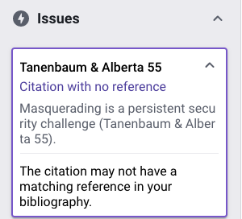
Grammar Guide
Grammar Guide searches your draft for any grammatical issues using US-English grammar rules. Any potential errors will be highlighted, categorized, and listed with suggestions on how they could be corrected.
Interpreting your results
Your Grammar Guide will detect any potential grammatical mistakes in your writing. A summary will be shown, and a list of all issues will appear below.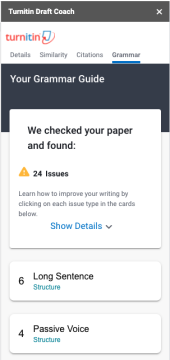
Select Show Details to reveal a summary of your issues. The four Issue categories that Grammar Guide uses to search against:
-
Grammar - The basic structure of language, in this case, US-English.
-
Mechanics - Language rules regarding the use of punctuation, capitalization, and spacing.
-
Usage - How and when to use words and their variations based on the context. Focuses more on the meaning of the word rather than the mechanics.
-
Structure - The arrangement of words, phrases, and clauses to make up a sentence.
We do not search for spelling mistakes (usually falls under the Mechanics category), but we may detect some suspected typos.
What information will Grammar Guide give me
Here is a breakdown of the details Grammar Guide will provide you with so that you can confidently make corrections to your writing.
.
| If the same grammatical error is detected more than once, we will gather each instance together and allow you to navigate between each one. We have found three instances of a missing comma in this example. |
.png)
|
|
Select the issue card to expand it. Here, Grammar Guide will explain why the issue was highlighted, and a description of the grammatical rule will be included underneath.
A snippet of your writing will be provided to help you locate where the specific issue has been detected. Grammar Guide will also pinpoint in bold exactly where it has found the issue. Use the arrows provided to navigate to the next issue of this type. |

|
|
Select Show Examples to reveal examples of the grammar rule being used correctly. Use these insights to help you correct your own writing. |
|
|
|
|
|
Select Hide Examples to remove the examples from view. |
What can I do with the information included in my checks?
Use the information in your Grammar Guide to inform changes that you should make in your draft. Consider the following when viewing your Grammar Guide results:
-
Choose one specific issue to review at a time. Use the arrows within the issue tile to navigate between each instance of that specific issue found within your draft.
-
Read each issue description carefully and bear it in mind when you construct the rest of your draft or when making amendments.
-
You may determine that no revisions are necessary for a particular issue. Use the rules of the English language and your best judgment when evaluating your writing.
-
Run as many checks as you like, until you are confident with your final draft.
Was this page helpful?
We're sorry to hear that.
